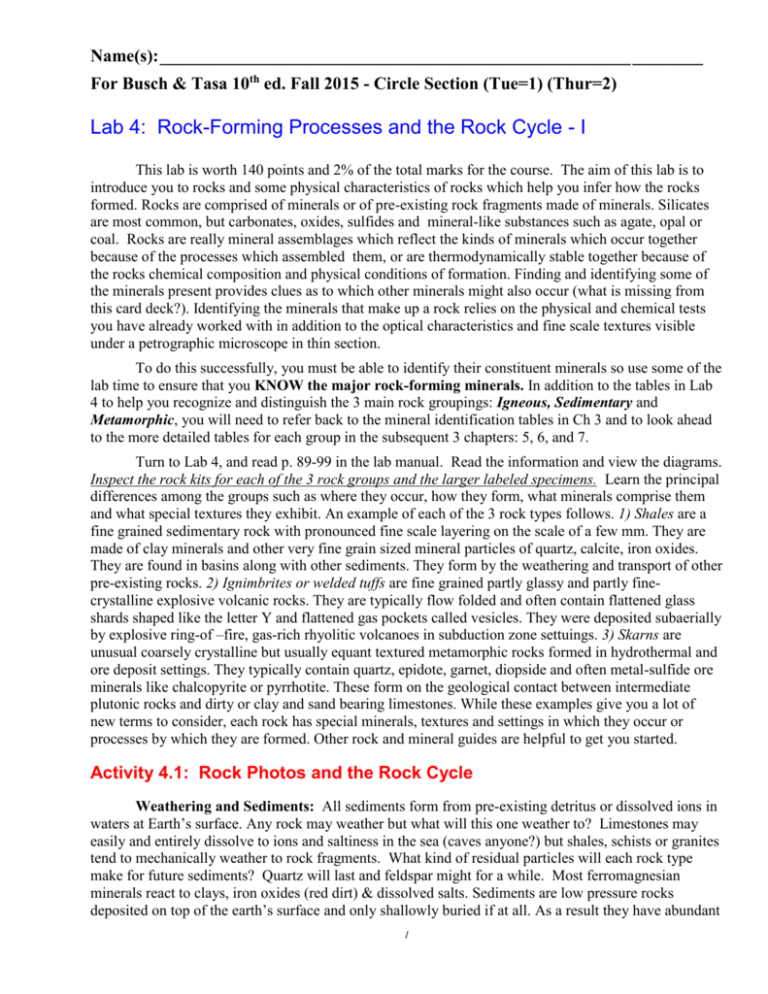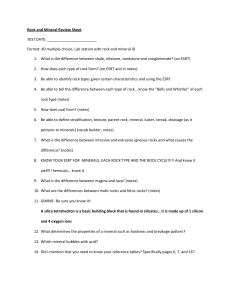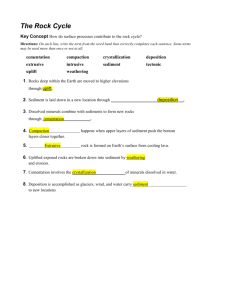04-Rock-Cycle-AGI
advertisement

Name(s): _____________________________________________________ ________ For Busch & Tasa 10th ed. Fall 2015 - Circle Section (Tue=1) (Thur=2) Lab 4: Rock-Forming Processes and the Rock Cycle - I This lab is worth 140 points and 2% of the total marks for the course. The aim of this lab is to introduce you to rocks and some physical characteristics of rocks which help you infer how the rocks formed. Rocks are comprised of minerals or of pre-existing rock fragments made of minerals. Silicates are most common, but carbonates, oxides, sulfides and mineral-like substances such as agate, opal or coal. Rocks are really mineral assemblages which reflect the kinds of minerals which occur together because of the processes which assembled them, or are thermodynamically stable together because of the rocks chemical composition and physical conditions of formation. Finding and identifying some of the minerals present provides clues as to which other minerals might also occur (what is missing from this card deck?). Identifying the minerals that make up a rock relies on the physical and chemical tests you have already worked with in addition to the optical characteristics and fine scale textures visible under a petrographic microscope in thin section. To do this successfully, you must be able to identify their constituent minerals so use some of the lab time to ensure that you KNOW the major rock-forming minerals. In addition to the tables in Lab 4 to help you recognize and distinguish the 3 main rock groupings: Igneous, Sedimentary and Metamorphic, you will need to refer back to the mineral identification tables in Ch 3 and to look ahead to the more detailed tables for each group in the subsequent 3 chapters: 5, 6, and 7. Turn to Lab 4, and read p. 89-99 in the lab manual. Read the information and view the diagrams. Inspect the rock kits for each of the 3 rock groups and the larger labeled specimens. Learn the principal differences among the groups such as where they occur, how they form, what minerals comprise them and what special textures they exhibit. An example of each of the 3 rock types follows. 1) Shales are a fine grained sedimentary rock with pronounced fine scale layering on the scale of a few mm. They are made of clay minerals and other very fine grain sized mineral particles of quartz, calcite, iron oxides. They are found in basins along with other sediments. They form by the weathering and transport of other pre-existing rocks. 2) Ignimbrites or welded tuffs are fine grained partly glassy and partly finecrystalline explosive volcanic rocks. They are typically flow folded and often contain flattened glass shards shaped like the letter Y and flattened gas pockets called vesicles. They were deposited subaerially by explosive ring-of –fire, gas-rich rhyolitic volcanoes in subduction zone settuings. 3) Skarns are unusual coarsely crystalline but usually equant textured metamorphic rocks formed in hydrothermal and ore deposit settings. They typically contain quartz, epidote, garnet, diopside and often metal-sulfide ore minerals like chalcopyrite or pyrrhotite. These form on the geological contact between intermediate plutonic rocks and dirty or clay and sand bearing limestones. While these examples give you a lot of new terms to consider, each rock has special minerals, textures and settings in which they occur or processes by which they are formed. Other rock and mineral guides are helpful to get you started. Activity 4.1: Rock Photos and the Rock Cycle Weathering and Sediments: All sediments form from pre-existing detritus or dissolved ions in waters at Earth’s surface. Any rock may weather but what will this one weather to? Limestones may easily and entirely dissolve to ions and saltiness in the sea (caves anyone?) but shales, schists or granites tend to mechanically weather to rock fragments. What kind of residual particles will each rock type make for future sediments? Quartz will last and feldspar might for a while. Most ferromagnesian minerals react to clays, iron oxides (red dirt) & dissolved salts. Sediments are low pressure rocks deposited on top of the earth’s surface and only shallowly buried if at all. As a result they have abundant 1 open pore spaces and are often filled with economically important resources like ground water, petroleum or natural gas. Partial Melting: All igneous rocks originated by partial melting, moved upwards in the crust by buoyancy and either intruded or extruded by flow and cooled to form solid rocks. The mantle peridotite partially melts to make basalt at about 1250°C. The gabbro or amphibolite lower crust can partially melt to make rhyolite at about 1000°C. Pure quartz doesn’t melt until 1700°C. Calcite usually doesn’t survive to get hot enough to melt because it decrepitates to carbon dioxide (CO2 (g) ) and Calcium Oxide (CaO) or another calcium bearing mineral at temperatures above 750°C. Most rocks can partially melt if they get hot enough but what kind of melts could each particular rock generate? Be specific: Rhyolite, Basalt, Carbonatite, etc. Metamorphism: Any rock may get strained and re-crystallized by changes of pressure, temperature, stresses and fluids that collectively add up to metamorphism. Judging from the minerals already present what new minerals would form from the bulk composition of each rock pictured or in the specimens provided? Clays may re-crystallize into micas and aluminosilicate minerals (kyanite, sillimanite, andalusite). Pure quartz or calcite just stay as quartz or calcite but a marly sediment containing calcite, quartz and clays make Ca-rich alumino-silicate rocks or coarse grained skarns with minerals like tremolite, actinolite, diopside or grossularite garnet. Shales may regionally metamorphose into schists or gneisses, or get baked to hornfels where cut by intrusions. Granites may metamorphose into gneisses. Volcanic rocks may metamorphose into greenstones (low temperatures and pressures) or blueschists (low temperatures and very high pressures). The final rock depends both on the starting minerals and on the physical conditions (Strain, P, T, fluids). Like cooking, the same starting composition may yield very different products depending on what happens along the way. Sample# Rock Properties Classification/Name Origin/Formation Future Changes A Glassy fractured devitrified and discoloured IGN-Obsidian Quenched fast from subaerial volcano Clay, salt Schist Remelt E I Crystalline, non foliated, calcite MET-Marble Fine grained leaf fossil hematite cement SED-Redbed Fossiliferous Siltstone Recrystallized limestone convergent marg Salts Clastic lacustrine or riverine on land Mud & salts Marble Schist Rhyolite melt 2 Activity 4.3:Practice with Abundant Rock Forming Minerals Mineral name Formula Group 1. Olivine 2. Serpentine 3. Kaolinite 4. Muscovite 5. Chlorite 6. Biotite 7. Gypsum 8. Orthoclase 9. Andesine 10. Halite 11. Augite 12. Hornblende 13. Garnet 14. Calcite 15. Quartz 3 Rock Type Geological Setting 4.4: Recognizing Rock Textures Rock textures like mineral assemblages and grain sizes result from the physical and chemical conditions present at the time the rock crystallized, recrystallized or collected and cemented as a pile of individual grains. Most textures are unique to a single class of rocks: igneous, metamorphic or sedimentary. Examine the photos of the 12 rocks on p 124 and fill the boxes in each column with the terms and textures that apply. Some columns may get no term and others might get more than one. For example an igneous rock with an interlocking crystalline texture does not have any clastic grains at all and metamorphic rocks will rarely appear glassy or vesicular but might have deformed amygdules (vesicles filled by secondary minerals. Do not lose points by putting terms where none belong. (30) Rock name (Ig, Met or Sed) Red-Green-Yel Glassy Fine Crystalline: <1mm Vesicular Heterogranular Coarse Equigranular >1mm 1. Gneiss 2. Coquina 3. Lava 4. Granite 5.Peridotite 6.Obsidian 7.Sandstone 8.Gneiss 9.Breccia 10.Shale 11.Schist 12Conglomerate 4 Clastic: Composition: Layers: Angular Bioclastic Rounded Mineral Clasts Flat Laminated Foliated Activity 4.5: Introduction to Rocks and the Rock Cycle A-1) Inspect Figure 4.2 on p. 114. Complete this circular rock cycle figure from p. 127 by colouring the arrows for the processes which make or characterize each of the 3 rock types. Colour any arrow which results in a sediment or creates a sedimentary rock yellow. Colour any arrow which results in a metamorphic rock green. Colour any arrow which results in an igneous rock red. Note: it is the process which counts here and the final product, and not necessarily what it was to begin with! The colour matches the process and the final product, not the starting rock. For example, an obsidian can weather at the surface to dissolved salts and residual clays to make runoff and soils. Because of the surface weathering process and the sediments it generates, the process is sedimentary so should be coloured yellow. (11) A-2) Complete the table below the figure and place an x in the column if some of that type of rock contains this feature or is formed by this process. This requires some reading and is a bit tricky as you can lose points for not putting in an x where you should or for putting in an x where you shouldn’t! (15) 5 4.5-B: Analyzing Rocks and Interpreting Rock Cycle Changes In column 1 list at least 2 specific terms for textures, minerals, fossils, cements. In column 2 name the rock. In the 3rd column, be specific as to the rock’s conditions of formation or original geological setting. Petrologists do this when the look at rocks to see not only what is before their eyes, but also they interpret the environment that created it. Finally in the last column, put 1 realistic example of a specific sedimentary, metamorphic and igneous process that could befall each rock in the rock cycle. The rocks a-e are all pictured on p. 120. Equivalent specimens in the lab are labeled 4.5a through 4.5e. (30) 6








